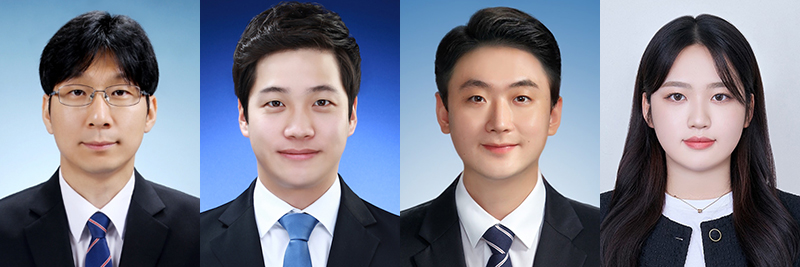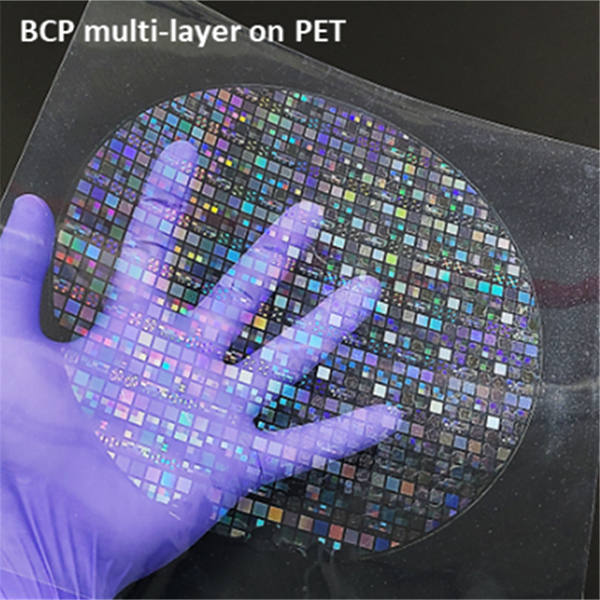커뮤니티
부경투데이
- 국립 부경대학교의 다양한 모습과 소식을 접하시면 부경대학교가 한번 더 가까워집니다.
| '듀얼 나노패터닝 반도체공정' 최초 개발(A new development in 'dual nanopatterning process') | |||
| 작성자 | 대외협력과 | 작성일 | 2023-08-31 |
| 조회수 | 1096 | ||
| '듀얼 나노패터닝 반도체공정' 최초 개발(A new development in 'dual nanopatterning process') | |||||
 |
대외협력과 |  |
2023-08-31 |  |
1096 |
부경대, ‘듀얼 나노패터닝 반도체공정’ 최초 개발
- 부산대·고려대·포스텍·한국세라믹기술원 공동연구 결과

△ 부경대 연구진들. 왼쪽부터 박운익 교수, 박태완 박사, 강영림 석사과정생, 강은빈 학석사통합과정생.
국립부경대학교는 박운익 교수(재료공학전공) 연구팀이 반도체 공정에서 8인치 웨이퍼에 20나노급 초미세 패턴을 형성하는 신개념 듀얼 나노패터닝(Dual nanopatterning) 공정을 최초로 개발했다고 밝혔다.
차세대 전자기기의 발전에 따라 다양한 전자소자의 제작을 위해서는 고집적 반도체 회로구현을 위한 나노패터닝 공정의 개발이 필수적이다. 현재 대표적인 나노패터닝 공정으로 포토리소그래피(Photolithography)가 주로 사용되는데, 패턴 해상도 한계, 고가의 장비, 복잡한 공정 단계와 같은 단점으로 인해 이를 대체하기 위한 새로운 공정 개발이 진행돼왔다.
저렴한 비용으로 높은 패턴 해상도를 나타내는 ‘패턴전사프린팅(Nanotransfer Printing)’이 새로운 대체 공정 중 하나로 꼽히는데, 이 공정 또한 패턴의 해상도가 마스터 몰드(master mold·거푸집)의 패턴 크기에 크게 의존하는 단점이 있다.
연구팀은 이 같은 문제를 해결하기 위해 패턴전사프린팅 공정에 실리콘(Si)이 함유된 블록 공중합체(block copolymer)의 자기조립 현상을 복합하는 방법을 적용, 8인치 웨이퍼 상에 규칙적으로 정렬된 20나노급 실리카(SiOx) 구조물을 형성하는 듀얼 나노패터닝 프로세스를 개발하는 데 성공했다.
박운익 교수는 “듀얼 나노패터닝 공정은 기존 패터닝 기술의 10분의 1 이상 저렴한 비용으로 더욱 복잡한 회로를 가진 고집적 패턴을 구현할 수 있어 차세대 반도체 기술 발전에 기여할 수 있을 것으로 기대한다.”라고 밝혔다.
이번 연구는 과학기술정보통신부 한국연구재단 기초연구실지원사업(BRL) 및 중견연구사업을 통해 수행됐으며, 연구결과를 담은 논문 ‘Direct Printing of Ultrathin Block Copolymer Film with Nano-in-Micro Pattern Structures’는 국제학술지 <Advanced Science>(IF: 17.5)에 지난 8월 21일 게재됐다.
이번 연구는 부경대 박운익 교수와 박태완 박사, 강영림 석사과정생, 강은빈 학석사통합과정생, 황건태 교수, 부산대 김광호 교수(글로벌프런티어 사업단장), 권세훈 교수, 이정우 교수, 이승기 교수, 고려대 남산 교수, 포스텍 최시영 교수, 한국세라믹기술원 정현성 박사 등 연구팀의 공동연구로 진행됐다. <부경투데이>

△ 듀얼 나노패터닝 공정으로 유연하고 투명한 플렉시블 기판 위에 형성된 20나노급 미세회로 구조물 이미지.
PKNU developed 'dual nanopatterning process' for the first time
- joint research with Busan national univ., Korea university, POSTECH, and KICET
Pukyong National University announced that professor Park Woon-Ik's (materials science and engineering major) research team was the first to develop an advanced concept and technology of dual nanopatterning process that forms a 20-nano ultra-fine pattern on an 8-inch wafer in the semiconductor process.
With the development of next-generation electronic devices, the development of nanopatterning processes to implement highly integrated semiconductor circuits is essential to produce various electronic devices. Photolithography is mainly used as the current representative nanopatterning process, but researchers have been developing new processes to replace it due to limitations in pattern resolution, expensive equipment, and complicated process steps.
'Nanotransfer printing', which exhibits high pattern resolution at a low cost, is considered one of the new alternative processes, but this has also been pointed out as a disadvantage in that the pattern resolution is largely dependent on the pattern size of the master mold.
To solve this problem, the research team applied a method that combined the self-assembly phenomenon of block copolymers containing silicon (Si) with the nanotransfer printing process and finally they succeeded in developing a dual nanopatterning process to form regularly aligned 20-nanometer silica (SiOx) structures on an 8-inch wafer.
Professor Park Woon-Ik said, "I expect that the dual nanopatterning process will greatly contribute to the development of next-generation semiconductor technology in the future because it can implement highly integrated patterns with more complex circuits at a cost that is one-tenth of that of existing patterning technologies."
This research was conducted through the basic research laboratory (BRL) and mid-career researcher program provided by the National research foundation of Korea (NRF) under the Ministry of science and ICT (MSIT), and the paper containing the research results, 'direct printing of ultrathin block copolymer film with nano-in-micro pattern structures' was published in the international academic journal <Advanced science> (IF: 17.5) dated on August, 21.
The research was jointly attended by professor Park Woon-Ik, Dr. Park Tae-Wan, master candidate Kang Young-Lim, and Kang Eun-Bin in integrated bachelor and master's program, professor Hwang Geon-Tae at Pukyong National University, professor Kim Gwang-Ho (director of NRF global frontier project), professor Kwon Se-Hun, professor Lee Jung-Woo and professor Lee Seoung-Ki from Busan national university, professor Nam San from Korea university, professor Choi Si-Young from the Pohang university of science and technology (POSTECH), and doctor Jung Hyun-Sung from Korea institute of ceramic engineering and technology (KICET). <Pukyong Today>